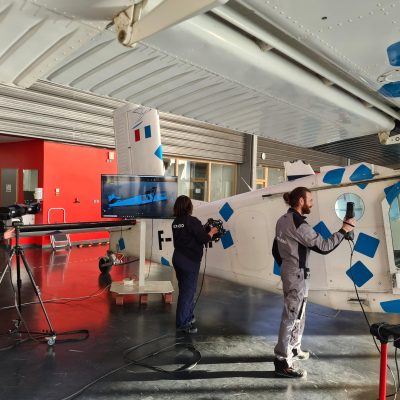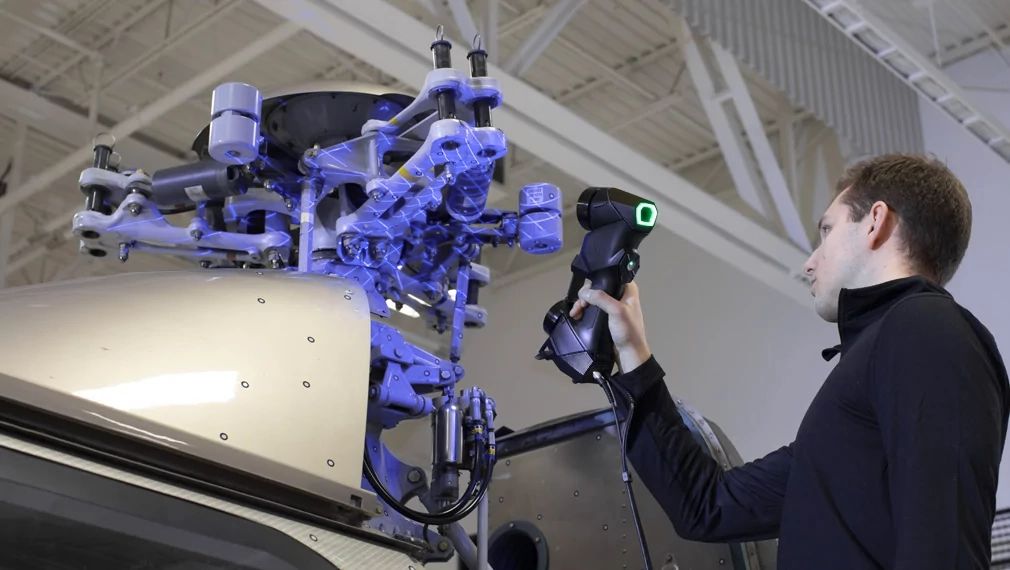May 23, 2024
Your Risk-Based Assessment Model is Only as Accurate as Your Data See the article- 1 How Airlines Use and Benefit from VXintegrity – Aerospace
- 2 Regular In-house Inspections, MRO Time and Cost Saved
- 3 Dents on Complex Geometries and Surfaces with a double Radius of Curvature
- 4 Traceable Data to Follow Dent Evolution Over Time
- 5 Effective Communication Between Engineers and OEMs
- 6 VXintegrity – Aerospace for Aircraft Surface 3D Assessment
- 7 Safe to Fly
How Airlines Use and Benefit from VXintegrity – Aerospace
Poorly documented dents can lead to more significant problems, potentially compromising the aircraft’s structural integrity or performance. They can trap moisture and lead to corrosion. The stress they generate can initiate fatigue cracks. Their impact on the structure can also affect the aircraft’s aerodynamic performance.
Failing to repair a dent in time regularly results in non-compliance with aviation regulations, leading to fines, grounding of the aircraft, or other penalties, not to mention the safety risks they pose to passengers and crew members. Consequently, airlines must have a robust system for documenting, assessing, and repairing dents and other damages to aircraft promptly and effectively.
Nevertheless, assessing the impact and severity of a dent is not easy. Data collection can occur in challenging conditions, outdoors, where light and weather can interfere. Dents can be located in hard-to-reach areas of the aircraft with complex curved geometries or on leading edges.
If you are an airline looking to improve your maintenance processes, this paper might be of interest. It presents a well-known technique that accurately assesses dents on aircraft under challenging conditions and on complex geometries while providing traceable data and comprehensive documentation.
When a Dent is Discovered
When ground crew or maintenance personnel discover a dent during routine inspection or maintenance check, a series of steps are taken to ensure the aircraft’s safety and airworthiness.
First, the size, depth, and severity of the dent are assessed. This involves measuring the dent and evaluating its impact on the aircraft’s structure and performance. Then, the details of the dent, including its dimensions and location, are documented in the aircraft’s maintenance records. Photographs are also taken, mainly in corroded areas, to provide a visual record of the dent.
How to Precisely Pinpoint the Location of a Dent
Airlines reference damages on aircraft using different standardized reference systems. The aircraft’s structural components, such as stringers (longitudinal members) and frames (transverse members), can be used to reference damage. For example, a dent might be described as being located “between stringers 5 and 6, near frame 12.”
Zones and stations of the aircraft, which are predefined areas and points along the aircraft’s structure, can also be used to specify the exact location of the damage. For example, a dent might be located at “Zone 100, Station 30,” corresponding to a specific area on the aircraft fuselage.
Waterline reference (WL), a horizontal plane used to specify the vertical position of damage on an aircraft, is another possible reference system. In this coordinate system, the waterline reference is measured vertically from a defined zero point. The waterline reference is used in conjunction with other reference systems, such as the buttock line (BL) for lateral (side-to-side) positioning and the station line (STA) for longitudinal (front-to-back) positioning, to precisely locate damage on the aircraft.
An X to Mark a Referenced Dent
Once maintenance technicians have assessed and documented a dent, and recorded its data in the system, a reference barcode is issued. Typically, they physically mark the dent with an X and assign it a serial number linked to their aircraft’s database. This helps them keep track of which dents have been inspected.
However, the X may disappear during the flight, generating confusion. As a result, ground crew or technicians may come across unmarked dents while loading or unloading baggage. Unable to tell if the dent has already been inspected, they must call an inspector, who will be charged to assess and document it. The thing is that, during this verification process, the plane is grounded, leading to delays in transit and potential airport fines or extra fees.
Undoubtedly, this method is not suitable. Airlines must have a better data collection process, more technological than a simple X marked with a pencil on a structure subjected to harsh atmospheric conditions.
Hot Areas Under Pressure
Hot areas are zones on an airplane that are more susceptible to dents due to their exposure to environmental factors or the roles they play in the aircraft’s operation. Hot areas include the leading edges of wings, engine nacelles and fan blades, entry and luggage doors, and pogo—a support strut used on some tailwheel or taildragger aircraft, which acts as a temporary support for the wings when the plane is parked.
These areas are the most damaged during operations because they are subject to impact from airborne particles or foreign objects, such as flying debris, birds, rocks, hailstones, and ice, leading to potential damage over time.
Regular inspections and maintenance are crucial to ensure that any damage to these areas is detected and repaired promptly to maintain the safety and integrity of the aircraft. However, inspecting every surface of those hot areas is challenging for inspectors due to several factors. First, the leading edges, engine outlets, and doors have curved and complex shapes and contours in addition to having reflective surface finishes. Second, due to the size of airplanes, inspections must sometimes take place outside directly on the tarmac.
White Light Limitations
White light technology is sensitive to reflective surfaces and ambient light. When the technology is used outdoors to measure dents in daylight, the ambient light can interfere with the white light source. The sunlight can also overpower the white light source, reducing the contrast and visibility of the light pattern projected onto the surface and leading to inaccurate measurements. Reflective surfaces, common on leading edges and engine outlets, can also scatter the incident light in various directions, making it challenging for the sensors to capture a clear, coherent signal for measurement.
White light solutions are also typically unsuitable for measuring large areas without significant effort in post-analysis. Without an encoding system and an interaction rule, they do not offer real-time reconstruction, which means they require taking images one by one with a robotic (and non-portable) system. Therefore, measuring all the dents on a plane after hailstorms can take days, and getting the rapport is even more burdensome.
Regular In-house Inspections, MRO Time and Cost Saved
Airlines have annual inspection requirements and constantly seek to optimize their inspection process. To achieve this, they can inspect certain areas in-house when the aircraft is unused, in latency periods, between two flights, or at night. By doing so, they can specify to the MRO which areas have already been checked, saving them time and reducing outsourcing costs.
To perform these inspections, airlines need reliable, easy-to-use technology with a short learning curve that any mechanic can use without certification. Additionally, they require a portable system that can be brought to the plane instead of the other way around, delivering human-independent results.
Dents on Complex Geometries and Surfaces with a double Radius of Curvature
Measuring leading edges and engine outlets, which often contain complex geometries and surfaces with a double radius of curvature, requires sophisticated processing algorithms. Traditional techniques are not effective nor repeatable on such geometries or surfaces, making an operator using a manual tool prone to errors.
However, with accurate and sophisticated algorithms, deviations can be recognized, and surfaces can be reconstructed based on “healthy” surfaces—free from defects and corrosion—or undamaged locations. Only Creaform offers such advanced algorithms specifically designed for aircraft assessment, which have been developed through years of innovation.
Traceable Data to Follow Dent Evolution Over Time
Airlines want a clear and complete map of all the dents in hot areas. They require comprehensive images of any potential damage that could have occurred between inspections.
With a tool that maintains a baseline, they can identify any new dents that may have appeared since the previous assessment and quickly determine if a specific dent has deteriorated over time. By monitoring dents over time, airlines make more informed decisions about when repairs are necessary. This can prevent unnecessary repairs and reduce maintenance costs while ensuring safety and better operating conditions for their aircraft.
Effective Communication Between Engineers and OEMs
Whenever damage is detected, a report must be sent to the manufacturer, who will provide the necessary repair guidelines. Therefore, every dent must then be documented with distances and references.
VXintegrity – Aerospace is the only solution that automatically measures the distance between dents and any other relevant reference, providing clear 3D visualization of damage with distance, unlike less precise 2D or hand-drawn images. These 3D images can then be sent to OEMs and other maintenance crew members for further analysis.

Damaged leading Edge automatically inspected by VXintegrity. Unlike traditional method the inspection is fast, repeatable and reliable.
By communicating this comprehensive 3D visualization of the plane structure, flight operators can easily confirm whether or not a dent has already been inspected. This solution effectively addresses the main issue of determining whether a dent (without a visible mark) has already been inspected or if it’s a new one that requires further investigation.
VXintegrity – Aerospace for Aircraft Surface 3D Assessment
VXintegrity – Aerospace is the market’s first dedicated 3D visualization software designed to assess and characterize dent damage on aircraft surfaces. More accurate and faster than traditional methods, the software limits the operators’ impact on measurements and shortens the time needed to generate final reports, providing airlines with comprehensive data on issues that require further analysis.
How is VXintegrity – Aerospace Unique
- Operator-independent measurements
- Algorithm sensitive to the finest detail
- Point tracking and surface reconstruction in real-time
- Defect characterization on different aircraft components, sizes, and surface finishes
- One click to report
- Interaction rule optimized for aerospace, facilitating communication about the extent of damage
Safe to Fly
Regular dent monitoring with traceable data enables airlines to confirm that each and every dent has been identified and appropriately documented. As a result, they optimize their maintenance operations and shorten their aircraft downtime. With VXintegrity’s Aerospace module, airlines can now efficiently perform these regular, in-house checks without always relying on MRO services, which reduces their maintenance costs and grounding time while enhancing the safety, reliability, and overall performance of the aircraft fleet.
Learn more about this inspection solution, which provides reliable, accurate, and operator-independent results.
Book your demo of VXintegrity – Aerospace












